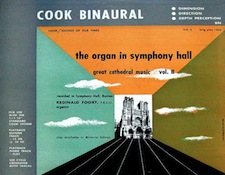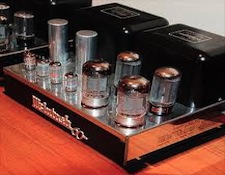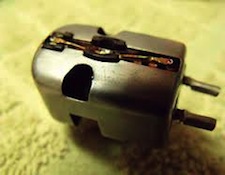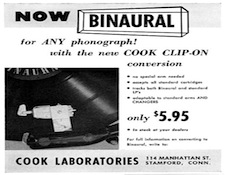It’s the time of year for saving money!
 When I first got into HiFi, things were different. For one
When I first got into HiFi, things were different. For one
thing, except for Emory Cook’s parallel-groove binaural discs (played with two
spaced phono cartridges on a single tonearm) and a few reel-to-reel stereo tapes,
everything was monophonic (We called it “monaural” then, perhaps to
differentiate it from “binaural”). For another, we, with the certainty of those
who know very little, were sure that the only things that could possibly have
any effect at all on the sound of a HiFi system were the phono cartridge and
the speakers.
We weren’t alone in that belief: With the enamored
gullibility of the 1950s, (It was 1954 when, at the age of twelve, I first
became a “HiFi Crazy”) most people believed
that electronics were “scientific”, and therefore as near to perfect as anyone
could ever want. The magazines of the time (Popular
Electronics and High Fidelity) largely
agreed, and most of the early “authorities”, the most influential of whom was
almost certainly Julian Hirsch, said that it was the electromechanical parts ―
the cartridge and the speakers – that, because of their less-than-perfect
mechanical limitations, were responsible for most of the sonic differences
between one system and another.
Even though we all lusted after a “Mac 30” (or even, please
God, a “Mac 60”, please, please) it seemed perfectly reasonable that the
electronics weren’t going to make any difference to the sound: After all, all
of the electronics of the time claimed THD and IM distortion figures of less
than 1% (certainly, we thought, no one could possibly hear that little
distortion) and all claimed frequency response of 20 to 20,000cps (We didn’t
use “Hertz” [Hz] yet), plus or minus no more than 3dB. That was far better than
the response range of the available records at the time (the typical frequency
response range of even the best tape recorders, microphones, and disc cutting
heads of the day was only claimed to be 50 to 15,000cps +/- 3dB) so we were
perfectly happy with our home-built Heathkit or EICO electronics, and gave no
thought to their sound at all.

As to speakers and cartridges, well, the differences were
OBVIOUS. There was no comparison at all between what we kids – my pals and I –
could afford or scrounge together and, for example, an Electro-Voice Patrician,
a Lansing Hartsfield, or (Wonder and Glory of all wonders and glories) a Bozak
B310, or even between ours and many of the, less expensive but still
unavailable to us, other speakers on the market. Speakers CERTAINLY made a
difference.
Cartridges, too: Until the General Electric “Variable
Reluctance” magnetic cartridges came along, we were all using high output (1
VOLT or more) crystal or ceramic cartridges. Then came the GE cartridge and a
revolution: Its output was so low that I had to spend $13 (big bucks for a
kid!) for a one-tube (12AU7, If I remember correctly) Fisher preamp to boost it
up to where my amp could deal with it. As compared to what I had had before, though,
it was a world of improvement.
The other parts of our systems fell, along with our
electronics, into the “doesn’t affect the sound” category; not because, like
the electronics, they were essentially “perfect”, but because being “part of
the sound” wasn’t their job: The turntable was just something to spin the
records and, as long as it had satisfactorily low wow, flutter, and rumble, it
was just fine. The tonearm was just something to hold the cartridge. And the
wires? They were just wires, and what we all used (and made for ourselves) was
nickel-a-foot Belden microphone cable with two-for-a-nickel cardboard-spaced
“tulip” RCA connectors for hookup, and lampcord for the speaker.
Although we had no way of knowing it, a very major reason
why so much of our system seemed to make so little difference was that we were
listening in mono. With not even any
conception of imaging, soundstaging, or ambience (other than “echo”) those
weren’t things that we listened for, and, when they weren’t there, we didn’t
notice their absence.

When, in 1957, stereo records (and a low-output
Electro-Voice ceramic cartridge to play them) came along, a new door was opened
that, frankly, most of us – even those who had “gone stereo” – didn’t go
through. We were too busy enjoying the glories of Left and Right and spending a
now-utterly-incomprehensible amount of time listening raptly to ping pong games
and marching bands, and grinning like loons as fire engines, jet fighters, and
steam locomotives roared through our rooms at joyously cataclysmic volume.
In fact, though, even if we had known about the real
potential of stereophonic sound, we were probably just too early in the cycle
to actually pass through that “door” and take full advantage of it: Mono didn’t really require “time aligned”
drivers, so most speakers other than those from Tannoy didn’t offer them and
buyers didn’t yet know enough to demand them for their stereo systems. Linn
hadn’t yet demonstrated undeniably that turntables could affect sound quality.
Randall Research and Monster cable hadn’t yet shown those who were willing to
believe their ears that cables CAN be heard and DO affect overall system
performance. With both imaging and soundstaging unknown, no one had even
discovered yet that both imaging and soundstaging could depend on speaker
placement, and “bookshelf” speaker systems were really called that because people
really bought them to be placed on a bookshelf (where, as on a “boombox”, they
would probably be too close together to actually produce a realistic image).
Eventually, though people learned: Speakers got better; “bookshelf” speakers
became “monitors” and were moved off the shelf to stands on the floor, well
away from the walls; better speakers, better turntables, better tonearms,
better cables, and better recording techniques helped people to hear recorded
soundstage and ambience for the first time, and the result was both better
recordings and better electronics.

And at that time, we finally learned what’s important: Everything. It all, every element of the
recording, the system that it’s played on, and even the room that it’s played
in is important. There is no contributing link
anywhere along the chain that doesn’t
affect the sound to at least some degree.
ATTENTION TROLLS: I’m not suggesting that there is no snake oil out there, but we’ve finally gotten to the point where each person, with
his own ears, on his own system, in his own room, can and must decide what works and
what doesn’t, and that’s exactly where we should
be. Good for Us!






My fave quote from the article, “we’ve finally gotten to the point where each person, with his own ears, on his own system, in his own room, can and must decide what works and what doesn’t, and that’s exactly where we should be.”